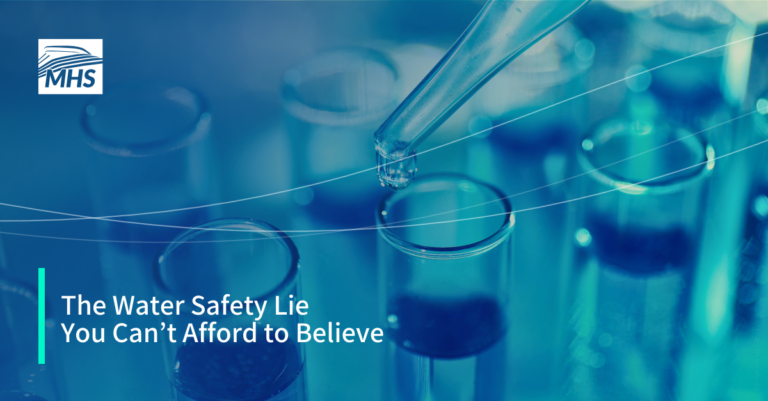A reliable supply of potable water is essential for maritime operations, whether for drinking, handwashing, food preparation, or sanitation. While definitions of “safe” water vary globally, the fundamental expectation is that it must be free from contaminants that pose immediate or long-term health risks.
For much of history, water quality was judged by appearance, smell, and taste. But just as food can appear fresh while harboring invisible pathogens, water can contain harmful substances with no obvious warning signs. This raises a critical question: how do we truly ensure water safety?
Regrettably, many in our industry still promote the belief that water sampling alone guarantees a safe supply. Yet, as the author Christopher Moore aptly stated, “Routine feeds the illusion of safety.”
When it comes to a ship’s potable water systems, assuming that a negative test report guarantees it’s free from contaminants is a risky misconception—one that could have serious consequences for the health of everyone on board.
Table of Contents
A Word on Water Quality Standards
Water quality standards are shaped by scientific research and expert judgment, using the best available data on the potential health risks. However, these standards are not uniform across all regions, underscoring the ambiguity in defining what constitutes “safe” water.
While the World Health Organization (WHO) provides a global benchmark for drinking-water quality, some of its guidelines—particularly regarding the long-term effects of trace chemical exposure—remain based on limited and inconclusive data.
As a result, compliance with quality standards does not offer an ironclad guarantee that water is entirely risk-free. Likewise, exceeding certain thresholds does not automatically render water unsafe in every instance. (This point will likely resonate with anyone who has dealt with a local health authority declaring a vessel’s water non-potable due to Trihalomethane levels exceeding a country’s threshold in just a few samples…)
Given these nuances, it’s clear that simply meeting drinking-water quality standards alone does not ensure the safety of a ship’s water supply. Water quality is influenced by a range of dynamic factors that can’t be fully addressed by periodic testing.
The key lies in maintaining continuous, proactive oversight; an effort that requires a deeper understanding of the inherent limitations of water sampling.
The Limitations of Water Testing
Water analysis is a valuable tool, but it is not a foolproof safeguard. Many assume that if test results meet regulatory guidelines at the time of sampling, the water must be safe. However, this overlooks a fundamental flaw: testing provides only a snapshot of water quality at a single moment in time.
Water conditions can shift rapidly due to fluctuations in source quality, biofilm development, disinfection byproduct formation, or contamination within the distribution system itself. A sample collected in the morning may not reflect conditions later that day, let alone in the days or weeks that follow.
This is particularly relevant for waterborne pathogens like Legionella spp., which thrive in stagnant water and pose a greater risk in low-flow areas. Since it’s impractical to sample every point in a vessel’s potable water system, a test from one location may fail to detect local colonization elsewhere.
Moreover, testing for Legionella is not an effective control measure. Lab results from shore-based facilities typically take weeks to process, making them unsuitable for real-time monitoring.
The true purpose of water sampling is not to certify that water is safe, but rather to validate that control measures—such as chlorine levels, water temperature, and pH—are functioning as intended. It serves as a check on the effectiveness of a ship’s overall water management strategy, not as definitive proof of its potability.
Treating periodic testing as the benchmark for safety fosters a false sense of security. Keeping a ship’s water supply safe requires a proactive, continuous approach that extends beyond routine sampling to encompass comprehensive water management strategies.
A Smarter Approach to Water Safety
Relying on analysis as the primary assurance that your water is free from contamination is misguided. While compliance with drinking-water quality guidelines and routine sampling are important, they do not account for the dynamic conditions within a ship’s potable water systems.
A more effective approach lies in proactive risk management. Maintaining water quality requires continuous monitoring, preventive controls, and systematic oversight—not just periodic checks.
As W. Edwards Deming famously said, “You can’t inspect quality into a product. It is already there or it isn’t.” The same principle applies to a vessel’s potable water. Testing alone does not ensure safety. A well-designed and well-maintained system does.
This philosophy is at the core of Water Safety Plans (WSPs), the internationally recognized framework for safeguarding potable water. By identifying potential hazards, implementing control measures, and validating their effectiveness, WSPs provide a comprehensive defense against waterborne threats.
Water safety is not a single test result. It is the outcome of a well-managed system. The goal is not to react to problems after they arise but to prevent them in the first place.
This is what truly protects the health of everyone on board.

